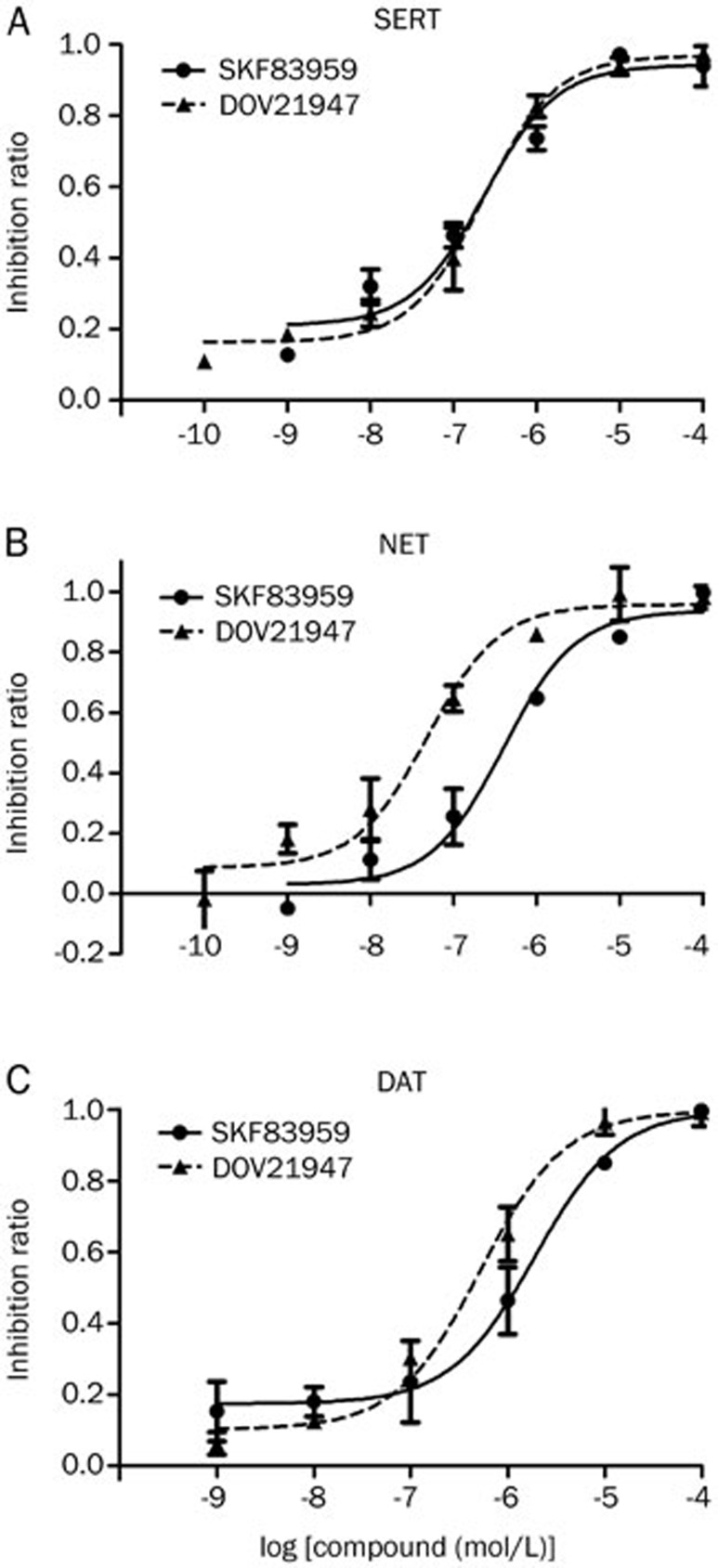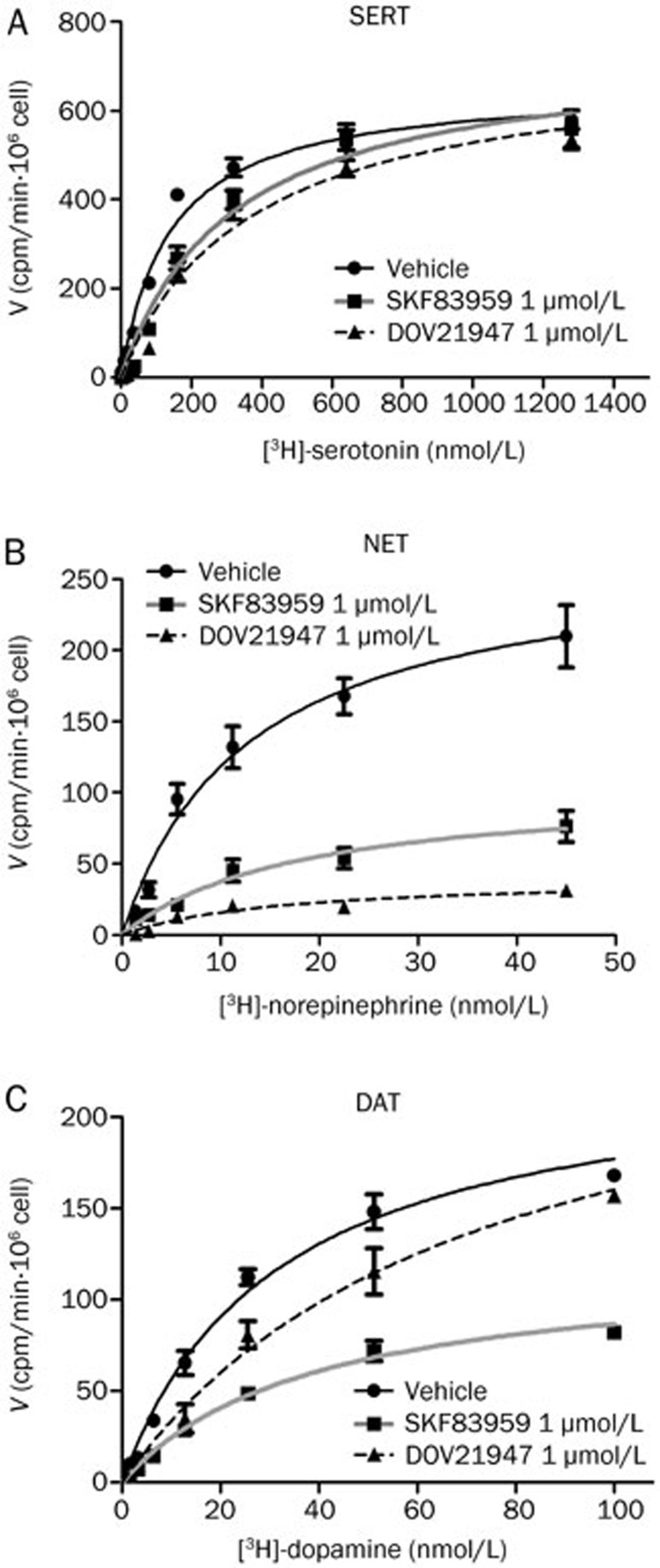Abstract
Aim:
SKF83959 (3-methyl-6-chloro-7,8-hydroxy-1-(3-methylphenyl)-2,3,4,5-tetrahydro-1H-3-benzazepine) is an atypical dopamine receptor-1 (D1 receptor) agonist, which exhibits many D1 receptor-independent effects. In the present work, we examined the effects of SKF83959 on monoaminergic transporters in vitro and its anti-depressant activity in vivo.
Methods:
Human serotonin transporter (SERT), norepinephrine transporters (NET) or dopamine transporters (DAT) were stably expressed in CHO cells. The uptake kinetics of SERT, NET, and DAT were examined using [3H]-serotonin, [3H]-norepinephrine or [3H]-dopamine, respectively. A triple reuptake inhibitor DOV21947 was used as the positive control. Tail suspension test and forced swimming test were conducted in mice. SKF83959 or DOV21947 (2–8 mg/kg) were intraperitoneally injected 30 min before the tests.
Results:
SKF83959 was a competitive inhibitor of SERT (Ki=1.43±0.45 μmol/L), but a noncompetitive inhibitor of NET (Ki=0.60±0.07 μmol/L) and DAT (Ki=9.01±0.80 μmol/L). In contrast, DOV21947 was a competitive inhibitor of SERT (Ki=0.89±0.24 μmol/L) and DAT (Ki=1.47±0.31 μmol/L) and a noncompetitive inhibitor of NET (Ki=0.18±0.04 μmol/L). In mice, both SKF83959 and DOV21947 elicited anti-depressant activity in a dose-dependent manner.
Conclusion:
SKF83959 functions as a novel triple reuptake inhibitor in vitro and exerts anti-depressant effects in vivo.
Keywords: SKF83959, monoamine transporter, serotonin, norepinephrine, dopamine, depression, DOV21947
Introduction
Depression is a severe and chronic mental disorder that affects a large population worldwide1,2. The development of effective anti-depressants with less adverse effects remains a challenge in pharmaceutical research. Within the past few decades, biogenic amine uptake inhibitors have been the mainstay for the treatment of depression, such as the prototypical tricyclic anti-depressants, the selective serotonin uptake inhibitors and the so-called “second” generation dual serotonin/norepinephrine uptake inhibitors with a “cleaner” side effect profile3.
Despite these advances, all these drugs often require 3 weeks to take effect. Moreover, nearly 30%–40% of patients with depression were not responsive to these therapies4. Recent studies have shown that a compound producing an immediate increase in synaptic dopamine concentrations would result in a more rapid onset of relief and a shortening or elimination of the therapeutic lag5. Thus, triple uptake inhibitors have become a focal point in anti-depressant drug development. Furthermore, some of these drugs have shown promising responses in clinical trials6,7,8,9.
The atypical dopamine receptor-1 (D1 receptor) agonist, 3-methyl-6-chloro-7,8-hydroxy-1-[3-methylphenyl]-2,3,4,5-tetrahydro-1H-3-benzazepine (SKF83959) has shown various biological functions in vitro and in intact animals. Unlike the typical D1 receptor agonists, SKF83959 does not stimulate the production of cyclic adenosine monophosphate (cAMP) via D1-like receptor-mediated activation of the Gs protein10,11,12,13; instead, it selectively activates the Gq protein via the D1-like receptor, which results in the production of inositol triphosphate14,15,16,17,18,19,20. In animals, this drug was found to increase eye blinking in monkeys and rats and to elicit excellent anti-Parkinsonism effects in a primate model as well as in a unilateral-lesioned rodent model21,22,23. The anti-Parkinsonism effects were shown to be independent of D1 dopamine receptor–stimulated cAMP and may be associated with the drug-activated Gq/phospholipase C pathway23,24.
In addition to the receptor-mediated events, recent data also indicated that the D1 receptor-independent pharmacological effects also played important roles in SKF83959-mediated biological responses. For example, we found that potent neuronal protection of the drug was only partially dependent on the D1 receptor25 and that SKF83959 blocked Na+ channels26, modulated the delayed rectifier K+ channels27 and promoted the spontaneous release of glutamate in rat somatosensory cortical neurons28.
In the present work, we examined whether SKF83959 effectively inhibited the uptake activity of the serotonin transporter (SERT), norepinephrine transporter (NET) and dopamine transporter (DAT), by functioning as a potent triple uptake inhibitor. Moreover, we also examined the anti-depressant activity of SKF83959 in vivo.
Materials and methods
Animals
Male C57BL/6J mice, weighing 18–20 g, were purchased from Shanghai Laboratory Animal Co, Ltd (Shanghai, China) and were housed in plastic cages (temperature: 21±1 °C) with air exchange every 20 min and an automatic 12 h light/dark cycle (light on from 7:00 AM to 19:00 PM). The animals were fed a standard laboratory diet, and water was provided ad libitum. All the experimental protocols were approved by the Institutional Animal Care and Use Committee of Shanghai Institute of Materia Medica, Chinese Academy of Sciences (SIMM-2011-06-ZXC-07) and were in compliance with the Guidelines for the Care and Use of Laboratory Animals (National Research Council, China, 1996).
Drugs and chemicals
(±)-SKF83959 was synthesized in the Synthetic Organic & Medicinal Chemistry Laboratory, Shanghai Institute of Materia Medica, Chinese Academy of Sciences (Shanghai, China). (1R,5S)-(+)-1-(3,4-Dichlorophenyl)-3-azabicyclo[3.1.0] hexane hydrochloride (DOV21947) was supplied by the Novel Technology Center of Pharmaceutical Chemistry, Shanghai Institute of Pharmaceutical Industry. [3H]-serotonin, [3H]-dopamine and [3H]-norepinephrine were purchased from PerkinElmer Inc (Waltham, MA, USA). Pargyline, tropolone and ascorbic acid were obtained from Sigma-Aldrich Co (St Louis, MO, USA). SKF83959, pargyline, tropolone and DOV21947 were dissolved in dimethyl sulfoxide at a concentration of 100 mmol/L stock solution. Prior to the experiments, the stock solutions were diluted with Hanks' Balanced Salt Solution (HBSS) buffer (NaCl 140 mmol/L, KCl 5.4 mmol/L, KH2PO4 0.4 mmol/L, NaHCO3 4.2 mmol/L, Na2HPO4 0.3 mmol/L, D-glucose 5.5 mmol/L, pH 7.2–7.4) to the designated concentrations (0.1 nmol/L–0.1 mmol/L).
The inhibitory effects of SKF83959 on SERT, NET, and DAT
Stably expressed transporter Chinese hamster ovary (CHO) cell lines were generated in our laboratory and have been previously used for compound activity tests29. These stably-expressed transporter cell lines were cultured in a mixture of Dulbecco's modified Eagle's medium (DMEM) and F12 (1:1, v/v) supplemented with 10% fetal calf serum (FCS) and antibiotics (10 units/mL penicillin, 100 μg/mL streptomycin, and 100 μg/mL G418). The culture dishes were maintained in a 37 °C incubator with a humidified atmosphere of 5% CO2.
We first investigated the inhibitory effects of SKF83959 on the uptake activity of SERT. The assays were performed as previously described30. Briefly, SERT-expressing CHO cells were seeded in 24-well cluster plates (Corning; NY, USA) at a density of 1.0×106 cells per well. After 12 h, the culture medium was removed, and 20 μL of SKF83959 or DOV21947 (final concentration: 0.1 nmol/L–0.1 mmol/L) and 160 μL HBSS buffer (containing 10 μmol/L pargyline, 10 μmol/L tropolone, and 10 μmol/L ascorbic acid) were added. After 10 min of incubation, [3H]-serotonin was added (final concentration: 2.4 nmol/L) for 10 min at 37 °C. The uptake was terminated by rinsing the cells three times with ice-cold PBS buffer. The cells were lysed using 0.1 mL of 2 mol/L NaOH. Nonspecific uptake was defined with Na+-free HBSS. The general procedures for norepinephrine and dopamine uptake were the same as those used for serotonin except for the different radiolabeled ligands29.
To further characterize the effects of SKF83959, we analyzed the kinetics of SKF83959 and DOV21947 on the corresponding transporters. For the Kt measurement, the corresponding cells were incubated with different concentrations of radiolabeled ligand ([3H]-serotonin: 1.2–1280 nmol/L; [3H]-norepinephrine: 1.4–45 nmol/L; [3H]-dopamine: 1.6–100 nmol/L). The uptake was then performed as previously described. The Kt values of the transporters were estimated using the Michaelis-Menten equation:
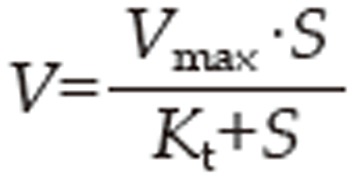 |
where S denotes the radiolabeled ligand concentration (nmol/L), Vmax denotes the maximal reuptake capacity (cpm/min·106 cell), and Kt denotes the Michaelis-Menten constant for the transporter-mediated transport (nmol/L).
Next, the Ki parameter was assayed. The saturation curves were re-examined in the presence of SKF83959 or DOV21947. Depending on the inhibitory pattern (competitive or non-competitive), the Ki values were then calculated using the Michaelis-Menten competitive inhibition equation:
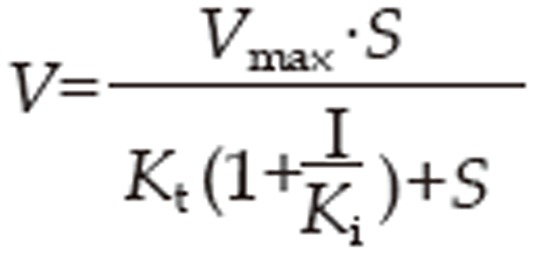 |
or noncompetitive inhibition equation:
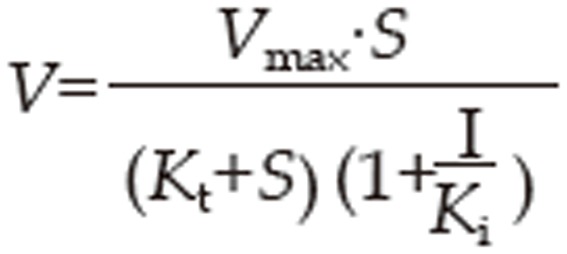 |
where S denotes the radiolabeled ligand concentration (nmol/L), Vmax denotes the maximal reuptake capacity (cpm/min·106 cell), I denotes the concentration of SKF83959 or DOV21947 (μmol/L), and Ki denotes the inhibition constant of SKF83959 or DOV21947 for the transporters (μmol/L).
Forced swimming test
The forced swimming test was performed as previously described31. The mice were placed in a transparent cylindrical beaker (height, ∼25 cm; internal diameter, 10 cm) containing water (22–24 °C) to a level of 15 cm. The water was always changed between trials. Thirty minutes before the test, SKF83959 or DOV21947 was intraperitoneally administered (2–8 mg/kg) to the mice. The immobility time was measured during a 5-min period by a trained observer who was blind to the treatment conditions. Each mouse was considered immobile if they were floating motionless or if they were only making the minimal amount of movements necessary to keep its head above the water surface.
Tail-suspension test
The tail suspension test was performed as previously described32. C57BL/6J mice were individually suspended 75 cm above the tabletop with an adhesive tape placed approximately 1 cm from the tip of the tail. The immobility duration was recorded for 6 min. Thirty minutes before the test, SKF83959 or DOV21947 was intraperitoneally administered (2–8 mg/kg). The duration of the immobility was measured by a trained observer according to the double-blind test rule. The mice were considered immobile only if they were hung passively and demonstrated no motion.
Data analysis
The IC50 values were expressed as the mean [95% confidence interval (95% CI)]. The difference between the IC50 was tested using weighted probit analysis. The other data were expressed as the mean±SEM. For multiple comparisons of the parameters, one-way ANOVA and the Dunnett's post-hoc test were used. Differences were considered significant if P<0.05. The data were analyzed using the Graphpad Prism software (GraphPad Software Inc, La Jolla, CA, USA, Version 5.0).
Results
Inhibition of SKF83959 on SERT, NET, and DAT
First, we tested the maximal inhibitory effect of SKF83959 on the three transporters. We found that SKF83959 (100 μmol/L) completely blocked the uptake activity. Moreover, the maximal inhibitory effect of SKF83959 was similar to that of DOV21947 (t-test, P>0.05).
Next, we studied the concentration-response relationship for SKF83959-inhibited uptake activity on the respective transporter. As shown in Figure 1 and Table 1, the IC50 of SKF83959 for SERT was similar to that of DOV21947 (t-test, P>0.05), but the IC50 values of SKF83959 for NET and DAT were greater than those of DOV21947 (t-test, P<0.05).
Figure 1.
The concentration-response curves of SKF83959 and DOV21947 on SERT, NET, and DAT. The uptake assays were performed as described in the Methods section. Various concentrations of SKF83959 or DOV21947 were incubated with [3H]-radiolabeled ligand for 10 min. The final concentration of [3H]-serotonin was 2.4 nmol/L, [3H]-norepinephrine was 1.4 nmol/L and [3H]-dopamine was 1.6 nmol/L. The nonspecific uptake activity was determined using Na+-free HBSS solution and the specific uptake activity was normalized as 100%. Each experiment was replicated at least three times. The data were expressed as the mean±SEM.
Table 1. Effects of SKF83959 and DOV21947 on the uptake activity of SERT, NET, and DAT.
| |
|
Compound |
|
|---|---|---|---|
| DOV21947 | SKF83959 | ||
| SERT | Maximal inhibiting ratio | 95.10%±1.55% | 97.35%±0.78% |
| IC50 (95% CI) (nmol/L) | 187 (100–533) | 242 (148–346) | |
| NET | Maximal inhibiting ratio | 99.65%±0.39% | 98.14%±2.17% |
| IC50 (95% CI) (nmol/L) | 93.5 (22.3–101) | 381 (233–672)b | |
| DAT | Maximal inhibiting ratio | 99.45%±0.74% | 99.20%±2.28% |
| IC50 (95% CI) (nmol/L) | 533 (335–828) | 1375 (1140–3170)b | |
The parameters were obtained from Figure 1. The values of IC50 were expressed as mean [95% confidence interval (95% CI)]. The difference between IC50 was tested by weighted probit analysis. Maximal Inhibiting ratio was expressed as mean±SEM. The nonspecific uptake activity was defined using Na+-free HBSS. bP<0.05 vs DOV21947.
These data clearly demonstrated that SKF83959 functions as a potent triple reuptake inhibitor.
Effects of SKF83959 on the uptake kinetics of SERT, NET, and DAT
To further characterize the effects of SKF83959 on the three transporters, we analyzed the kinetics of the transporters and checked the effect of SKF83959 on the uptake kinetics. The relationship between the uptake activity and the substrate concentration was provided by the Michaelis-Menten equation.
As shown in Figure 2A and Table 2, SKF83959 and DOV21947 did not alter Vmax (one-way ANOVA, P>0.05), but significantly increased the value of Kt (one-way ANOVA, P<0.05), indicating that SKF83959 and DOV21947 were two competitive inhibitors for SERT. Moreover, the Ki value of SKF83959 was not significantly different from that of DOV21947 (t-test, P>0.05).
Figure 2.
The effects of SKF83959 and DOV21947 on the transporting kinetics of SERT, NET, and DAT. The kinetics was assayed using [3H]-serotoin, [3H]-norepinephrine, or [3H]-dopamine in the presence of vehicle, SKF83959 or DOV21947. The nonspecific uptake activity was determined using Na+-free HBSS solution. Each experiment was replicated at least three times. The data were expressed as the mean±SEM.
Table 2. Effects of SKF83959 and DOV21947 on the transporting kinetics of SERT, NET, and DAT.
| |
|
Compound |
||
|---|---|---|---|---|
| Vehicle | DOV21947 | SKF83959 | ||
| SERT | Vmax (cpm/min·106 cells) | 6581±305 | 7216±732 | 7426±580 |
| Kt (nmol/L) | 104.50±21.09 | 362.20±23.32b | 316.70±64.13b | |
| Ki (μmol/L) | – | 0.89±0.24 | 1.43±0.45 | |
| NET | Vmax (cpm/min·106 cells) | 246.30±23.61 | 40.70±9.00b | 104.5±11.05be |
| Kt (nmol/L) | 13.24±3.13 | 13.69±2.21 | 13.30±2.19 | |
| Ki (μmol/L) | – | 0.18±0.04 | 0.60±0.08e | |
| DAT | Vmax (cpm/min·106 cells) | 224.00±14.6 | 265.20±29.29 | 116.00±7.45b |
| Kt (nmol/L) | 29.65±4.73 | 68.05±14.11b | 30.81±3.37 | |
| Ki (μmol/L) | – | 1.47±0.31 | 9.01±0.80e | |
The parameters were obtained from Figure 2. Data were expressed as mean±SEM. bP<0.05 vs vehicle. eP<0.05 vs DOV21947.
However, in contrast to the effect on SERT, both SKF83959 and DOV21947 reduced the Vmax value (one-way ANOVA, P<0.05, compared to vehicle) but did not change the Kt value (one-way ANOVA, P>0.05, compared to vehicle) in the NET uptake kinetics test, which was consistent with its noncompetitive pattern (Figure 2B, Table 2). The Ki of SKF83959 was greater than that of DOV21947 (t-test, P<0.05), indicating that the inhibitory activities of SKF83959 were weaker than that of DOV21947.
Similar to NET, SKF83959 also inhibited DAT in a noncompetitive manner. SKF83959 significantly decreased Vmax (t-test, P<0.05) without any change in Kt (t-test, P>0.05). Interestingly, in contrast to SKF83959, DOV21947 inhibited DAT in a competitive manner (Figure 2C, Table 2). The Ki of SKF83959 was greater than that of DOV21947 (t-test, P<0.05), indicating that the inhibitory activities of SKF83959 were weaker than that of DOV21947.
SKF83959 elicits potent anti-depressant activity in animal models
Because SKF83959 is a novel potent triple reuptake inhibitor, we tested the anti-depressant activity of this drug in mice. The forced swimming and tail suspension tests are two widely used methods to detect the anti-depressant efficacy of experimental drugs.
As shown in Figure 3A, SKF83959 decreased the immobility time in the forced swimming test in a dose-dependent manner. For the vehicle treated-mice, the immobility time was 158.40±10.31 s. The immobility time was significantly decreased (one-way ANOVA, P<0.001) in mice treated with SKF83959. Importantly, the reductions in the immobility time produced by SKF83959 were comparable to that produced by DOV21947 at the same doses (Figure 3A).
Figure 3.
Effects of SKF83959 on immobility in the forced swimming test and the tail suspension test. The behavioral assays were performed as described in the Methods section. Each experimental group contained 10 animals. (A) Forced swimming test. (B) Tail suspension test. The data were presented as the mean±SEM and analyzed using one-way ANOVA analysis followed by Dunnett's post-hoc test. bP<0.05, eP<0.05 vs the vehicle group.
Similarly, SKF83959 significantly reduced the immobility time in the tail suspension test (Figure 3B, one-way ANOVA, P<0.001). In the vehicle group, the immobility time was 135.00±7.44 s. A significant decrease was observed with 2 mg/kg of SFK83959 treatment. Furthermore, the reductions in the immobility time produced by SKF83959 were comparable to those in the immobility time produced by DOV21947 at the same doses (Figure 3B).
Discussion
In the present study, we found that SKF83959 was an effective inhibitor for the uptake activity of SERT, NET, and DAT. We further determined that SKF83959 functioned as a SERT competitive inhibitor, and behaved as a noncompetitive inhibitor for NET and DAT, which differed from the well-known triple uptake inhibitor DOV21947. Moreover, we provided convincing data demonstrating that SKF83959 was a potent anti-depressant agent in the forced swimming test and tail suspension test in mice. The present study showed, for the first time, that SKF83959 is a novel triple uptake inhibitor that elicits an anti-depressant effect. This finding may provide a novel pharmacological mechanism for the understanding of various biological functions of this drug.
Increasing the synaptic availability of biogenic amines is one important strategy used in anti-depressant therapy33. Following the application of dual uptake inhibitors (prototypic tricyclic anti-depressants and serotonin/norepinephrine uptake inhibitors) and the selective serotonin uptake inhibitor, triple uptake inhibitors were recently found to be promising chemical entities for the treatment of depression34, including DOV21947, PRC200SS, and GSK136070F. DOV21947 has demonstrated effective anti-depressant activity in a Phase III clinical study34. In addition, the most recent clinical studies have shown that DOV21947 begins to exert its anti-depressant activity after only one week of treatment35. The mean baseline score on the Montgomery-Åsberg Depression Rating Scale (MADRS) was significantly higher than that on the placebo-treated population. Our data indicated that SKF83959, with a benzazepine structure, is a novel and potent triple uptake inhibitor that elicits a comparable anti-depressant efficacy in vivo similar to DOV21947. Due to the difficulty in the design of triple uptake inhibitors36, the identification of a benzazepine-like structure as a novel category of triple uptake inhibitor may provide an alternative strategy in the development of anti-depressant drugs.
Analysis of the transporting kinetics of SKF83959 and DOV21947 revealed a significant difference between the two types of uptake inhibitors. We found that SKF83959 was a competitive inhibitor for SERT, but a noncompetitive inhibitor for NET and DAT. Consistent with previous reports6, we confirmed that DOV12947 was a competitive uptake inhibitor for DAT and SERT. Interestingly, we found that DOV21947 was a NET noncompetitive inhibitor, which has not been previously reported. Moreover, our data showed that the inhibitory potency of SKF83959 on SERT was similar to DOV21947, but was weaker on NET and DAT. Despite this difference, the same dose of SKF83959 and DOV21947 produced equivalent anti-depressant effects in different animal models (Figure 3). However, whether the differential inhibitory patterns in the kinetics between the two drugs contribute to the anti-depressant response remains unknown.
It appears that the IC50 and Ki values in our experiments were greater than those previously reported by Skolnick et al. In fact, our experiment was completely different from that of Skolnick6. Our experiment was based on uptake kinetics, whereas that of Skilnick was based on receptor binding. Thus, the Ki values between the two studies were completely different although they share a common symbol (Ki). In addition, the difference in the cell lines used (CHO vs HEK293) may also account for the discrepancy. It is well known that the IC50 value is closely dependent on the transporter density in the cell membrane as well as the expression level of the transporters. In addition, the difference in the transporters of the species employed (human transporter and rat transporter) also produced some distinct potency in the in vitro cell models10.
In summary, the present data indicated that SKF83959 displayed potent anti-depressant effects. The identification of SKF83959, a benzazepine structure, as a triple uptake inhibitor may provide a new avenue for the discovery of novel anti-depressant drugs.
Author contribution
Xing FANG, Lin GUO, Xue-chu ZHEN, and Bin ZHAO designed the research; Lin GUO, Xing FANG, and Jia JIA performed the research; Yong-yong ZHENG, Jian-qi LI, and Ao ZHANG contributed new reagents and discussed the results; Guo-zhang JIN and Xing FANG analyzed the data; and Lin GUO and Xue-chu ZHEN wrote the manuscript.
Acknowledgments
This work was financially supported by grants obtained from the National Natural Science Foundation of China (81130023, 81100918, and 81271214), National Basic Research Plan (973) of the Ministry of Science and Technology of China (2009CB522000 and 2011CB5C4403). We also appreciate the support provided by the Priority Academic Program Development of Jiangsu Higher Education Institutes (PAPD) and a grant obtained from the Jiangsu Science and Technology Commission (BY2011131).
References
- Belmaker RH, Agam G. Major depressive disorder. N Engl J Med. 2008;358:55–68. doi: 10.1056/NEJMra073096. [DOI] [PubMed] [Google Scholar]
- Duman RS. Neuronal damage and protection in the pathophysiology and treatment of psychiatric illness: stress and depression. Dialogues Clin Neurosci. 2009;11:239–55. doi: 10.31887/DCNS.2009.11.3/rsduman. [DOI] [PMC free article] [PubMed] [Google Scholar]
- Millan MJ. The role of monoamines in the actions of established and “novel” antidepressant agents: a critical review. Eur J Pharmacol. 2004;500:371–84. doi: 10.1016/j.ejphar.2004.07.038. [DOI] [PubMed] [Google Scholar]
- Kulkarni SK, Dhir A. Current investigational drugs for major depression. Expert Opin Investig Drugs. 2009;18:767–88. doi: 10.1517/13543780902880850. [DOI] [PubMed] [Google Scholar]
- Skolnick P, Popik P, Janowsky A, Beer B, Lippa AS. “Broad spectrum” antidepressants: is more better for the treatment of depression. Life Sci. 2003;73:3175–9. doi: 10.1016/j.lfs.2003.06.007. [DOI] [PubMed] [Google Scholar]
- Skolnick P, Popik P, Janowsky A, Beer B, Lippa AS. Antidepressant-like actions of DOV 21,947: a “triple” reuptake inhibitor. Eur J Pharmacol. 2003;461:99–104. doi: 10.1016/s0014-2999(03)01310-4. [DOI] [PubMed] [Google Scholar]
- Breuer ME, Chan JS, Oosting RS, Groenink L, Korte SM, Campbell U, et al. The triple monoaminergic reuptake inhibitor DOV 216,303 has antidepressant effects in the rat olfactory bulbectomy model and lacks sexual side effects. Eur Neuropsychopharmacol. 2008;18:908–16. doi: 10.1016/j.euroneuro.2008.07.011. [DOI] [PubMed] [Google Scholar]
- Liang Y, Shaw AM, Boules M, Briody S, Robinson J, Oliveros A, et al. Antidepressant-like pharmacological profile of a novel triple reuptake inhibitor, (1S,2S)-3-(methylamino)-2-(naphthalen-2-yl)-1-phenylpropan-1-ol (PRC200-SS) J Pharmacol Exp Ther. 2008;327:573–83. doi: 10.1124/jpet.108.143610. [DOI] [PubMed] [Google Scholar]
- Aluisio L, Lord B, Barbier AJ, Fraser IC, Wilson SJ, Boggs J, et al. In-vitro and in-vivo characterization of JNJ-7925476, a novel triple monoamine uptake inhibitor. Eur J Pharmacol. 2008;587:141–6. doi: 10.1016/j.ejphar.2008.04.008. [DOI] [PubMed] [Google Scholar]
- Andringa G, Drukarch B, Leysen JE, Cools AR, Stoof JC. The alleged dopamine D1 receptor agonist SKF 83959 is a dopamine D1 receptor antagonist in primate cells and interacts with other receptors. Eur J Pharmacol. 1999;364:33–41. doi: 10.1016/s0014-2999(98)00825-5. [DOI] [PubMed] [Google Scholar]
- Makihara Y, Okuda Y, Kawada C, Matsumoto M, Waddington JL, Koshikawa N, et al. Differential involvement of cyclase-versus non-cyclase-coupled D1-like dopamine receptors in orofacial movement topography in mice: studies with SKF 83822. Neurosci Lett. 2007;415:6–10. doi: 10.1016/j.neulet.2006.12.030. [DOI] [PubMed] [Google Scholar]
- Rashid AJ, O'Dowd BF, Verma V, George SR. Neuronal Gq/11-coupled dopamine receptors: an uncharted role for dopamine. Trends Pharmacol Sci. 2007;28:551–5. doi: 10.1016/j.tips.2007.10.001. [DOI] [PubMed] [Google Scholar]
- Fujita S, Kiguchi M, Kobayashi M, Kinsella A, Koshikawa N, Waddington JL. Assessment of jaw movements by magnetic sensor in relation to topographies of orofacial behaviour in freely moving rats: Studies with the dopamine D1-like receptor agonists SKF 83822 vs SKF 83959. Eur J Pharmacol. 2010;632:39–44. doi: 10.1016/j.ejphar.2010.01.018. [DOI] [PubMed] [Google Scholar]
- Panchalingam S, Undie AS. SKF83959 exhibits biochemical agonism by stimulating [35S]GTP gamma S binding and phosphoinositide hydrolysis in rat and monkey brain. Neuropharmacology. 2001;40:826–37. doi: 10.1016/s0028-3908(01)00011-9. [DOI] [PubMed] [Google Scholar]
- Cools AR, Lubbers L, van Oosten RV, Andringa G. SKF83959 is an antagonist of dopamine D1-like receptors in the prefrontal cortex and nucleus accumbens: a key to its antiparkinsonian effect in animals. Neuropharmacology. 2002;42:237–45. doi: 10.1016/s0028-3908(01)00169-1. [DOI] [PubMed] [Google Scholar]
- Jin LQ, Goswami S, Cai G, Zhen X, Friedman E. SKF83959 selectively regulates phosphatidylinositol-linked D1 dopamine receptors in rat brain. J Neurochem. 2003;85:378–86. doi: 10.1046/j.1471-4159.2003.01698.x. [DOI] [PubMed] [Google Scholar]
- O'Sullivan GJ, Clifford JJ, Tomiyama K, Koshikawa N, Drago J, Sibley DR, et al. D1-like dopamine receptor-mediated function in congenic mutants with D1vs D5 receptor “knockout”. J Recept Signal Transduct Res. 2004;24:107–16. doi: 10.1081/rrs-200032078. [DOI] [PubMed] [Google Scholar]
- Sahu A, Tyeryar KR, Vongtau HO, Sibley DR, Undieh AS. D5 dopamine receptors are required for dopaminergic activation of phospholipase C. Mol Pharmacol. 2009;75:447–53. doi: 10.1124/mol.108.053017. [DOI] [PMC free article] [PubMed] [Google Scholar]
- Ming Y, Zhang H, Long L, Wang F, Chen J, Zhen X. Modulation of Ca2+ signals by phosphatidylinositol-linked novel D1 dopamine receptor in hippocampal neurons. J Neurochem. 2006;98:1316–23. doi: 10.1111/j.1471-4159.2006.03961.x. [DOI] [PubMed] [Google Scholar]
- Undieh AS. Pharmacology of signaling induced by dopamine D1-like receptor activation. Pharmacol Ther. 2010;128:37–60. doi: 10.1016/j.pharmthera.2010.05.003. [DOI] [PMC free article] [PubMed] [Google Scholar]
- Andringa G, Stoof JC, Cools AR. Sub-chronic administration of the dopamine D1 antagonist SKF 83959 in bilaterally MPTP-treated rhesus monkeys: stable therapeutic effects and wearing-off dyskinesia. Psychopharmacology (Berl) 1999;146:328–34. doi: 10.1007/s002130051124. [DOI] [PubMed] [Google Scholar]
- Gnanalingham KK, Hunter AJ, Jenner P, Marsden CD. Selective dopamine antagonist pretreatment on the antiparkinsonian effects of benzazepine D1 dopamine agonists in rodent and primate models of Parkinson's disease — the differential effects of D1 dopamine antagonists in the primate. Psychopharmacology (Berl) 1995;117:403–12. doi: 10.1007/BF02246211. [DOI] [PubMed] [Google Scholar]
- Zhang H, Ma L, Wang F, Chen J, Zhen X. Chronic SKF83959 induced less severe dyskinesia and attenuated L-DOPA-induced dyskinesia in 6-OHDA-lesioned rat model of Parkinson's disease. Neuropharmacology. 2007;53:125–33. doi: 10.1016/j.neuropharm.2007.04.004. [DOI] [PubMed] [Google Scholar]
- Zhen X, Goswami S, Friedman E. The role of the phosphatidylinositol-linked D1 dopamine receptor in the pharmacology of SKF83959. Pharmacol Biochem Behav. 2005;80:597–601. doi: 10.1016/j.pbb.2005.01.016. [DOI] [PubMed] [Google Scholar]
- Yu Y, Wang JR, Sun PH, Guo Y, Zhang ZJ, Jin GZ, et al. Neuroprotective effects of atypical D1 receptor agonist SKF83959 are mediated via D1 receptor-dependent inhibition of glycogen synthase kinase-3 beta and a receptor-independent anti-oxidative action. J Neurochem. 2008;104:946–56. doi: 10.1111/j.1471-4159.2007.05062.x. [DOI] [PubMed] [Google Scholar]
- Chu HY, Wu Q, Zhou S, Cao X, Zhang A, Jin GZ, et al. SKF83959 suppresses excitatory synaptic transmission in rat hippocampus via a dopamine receptor-independent mechanism. J Neurosci Res. 2011;89:1259–66. doi: 10.1002/jnr.22653. [DOI] [PubMed] [Google Scholar]
- Chen XQ, Zhang J, Neumeyer JL, Jin GZ, Hu GY, Zhang A, et al. Arylbenzazepines are potent modulators for the delayed rectifier K+ channel: a potential mechanism for their neuroprotective effects. PLoS One. 2009;4:e5811. doi: 10.1371/journal.pone.0005811. [DOI] [PMC free article] [PubMed] [Google Scholar]
- Chu HY, Yang Z, Zhao B, Jin GZ, Hu GY, Zhen X. Activation of phosphatidylinositol-linked D1-like receptors increases spontaneous glutamate release in rat somatosensory cortical neurons in vitro. Brain Res. 2010. 1343. pp. 20–7. [DOI] [PubMed]
- Zheng YY, Guo L, Zhen XC, Li JQ. Synthesis and antidepressant activity of arylalkanol-piperidine derivatives as triple reuptake inhibitors. Eur J Med Chem. 2012;54:123–36. doi: 10.1016/j.ejmech.2012.04.030. [DOI] [PubMed] [Google Scholar]
- Zhao G, Li S, Qin GW, Fei J, Guo LH. Inhibitive effects of Fructus Psoraleae extract on dopamine transporter and noradrenaline transporter. J Ethnopharmacol. 2007;112:498–506. doi: 10.1016/j.jep.2007.04.013. [DOI] [PubMed] [Google Scholar]
- Porsolt RD, Le Pichon M, Jalfre M. Depression: a new animal model sensitive to antidepressant treatments. Nature. 1977;266:730–2. doi: 10.1038/266730a0. [DOI] [PubMed] [Google Scholar]
- Steru L, Chermat R, Thierry B, Simon P. The tail suspension test: a new method for screening antidepressants in mice. Psychopharmacology (Berl) 1985;85:367–70. doi: 10.1007/BF00428203. [DOI] [PubMed] [Google Scholar]
- Iversen L. Neurotransmitter transporters: fruitful targets for CNS drug discovery. Mol Psychiatry. 2000;5:357–62. doi: 10.1038/sj.mp.4000728. [DOI] [PubMed] [Google Scholar]
- Chen Z, Skolnick P. Triple uptake inhibitors: therapeutic potential in depression and beyond. Expert Opin Investig Drugs. 2007;16:1365–77. doi: 10.1517/13543784.16.9.1365. [DOI] [PubMed] [Google Scholar]
- Tran P, Skolnick P, Czobor P, Huang NY, Bradshaw M, McKinney A, et al. Efficacy and tolerability of the novel triple reuptake inhibitor amitifadine in the treatment of patients with major depressive disorder: a randomized, double-blind, placebo-controlled trial. J Psychiatr Res. 2012;46:64–71. doi: 10.1016/j.jpsychires.2011.09.003. [DOI] [PubMed] [Google Scholar]
- Guiard BP, El Mansari M, Blier P. Prospect of a dopamine contribution in the next generation of antidepressant drugs: the triple reuptake inhibitors. Curr Drug Targets. 2009;10:1069–84. doi: 10.2174/138945009789735156. [DOI] [PubMed] [Google Scholar]



